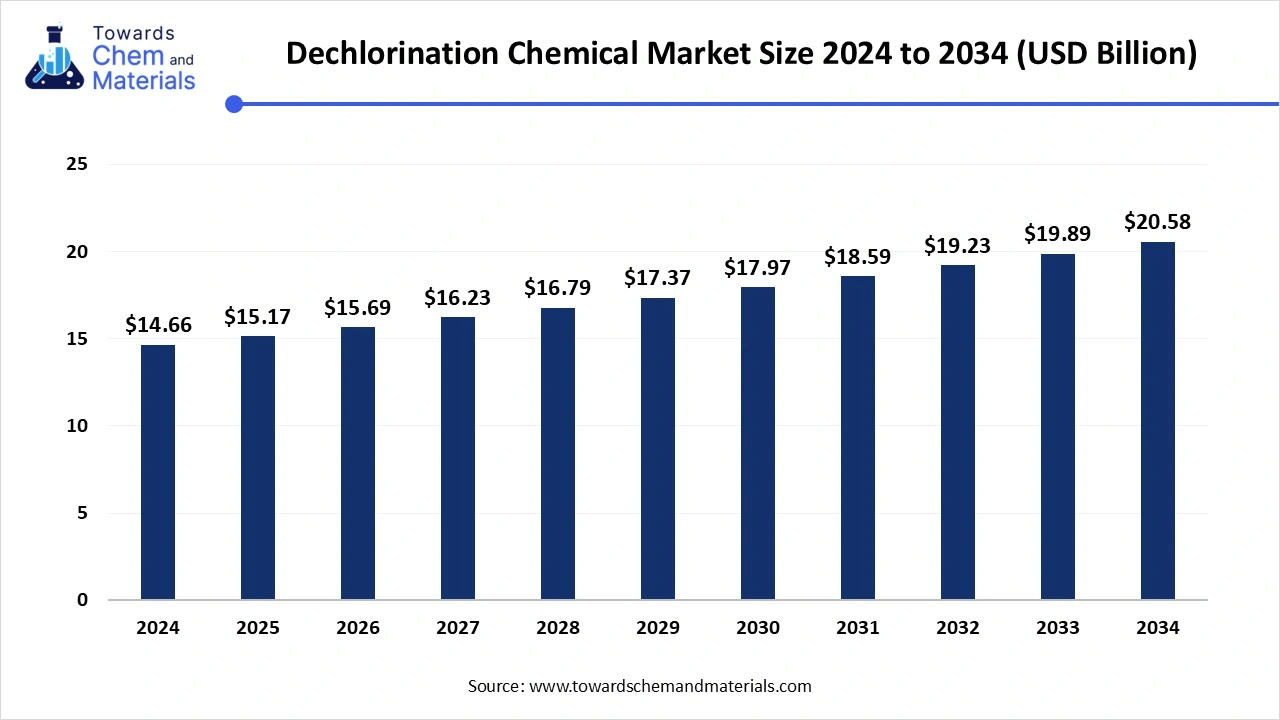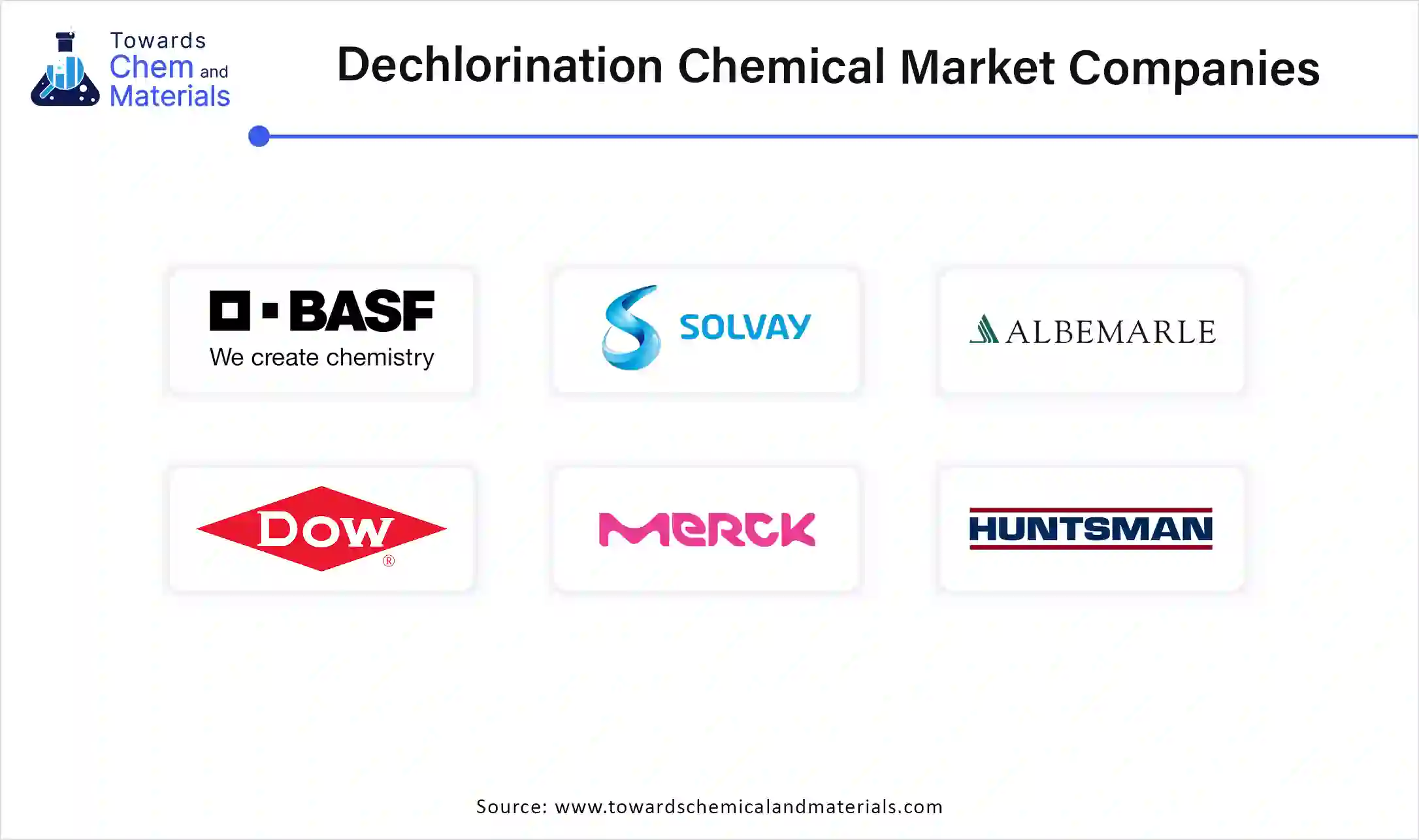April 2025
The global dechlorination chemical market size was valued at USD 14.66 billion in 2024 and is expected to hit around USD 20.58 billion by 2034, growing at a compound annual growth rate (CAGR) of 3.45% over the forecast period 2025 to 2034.The growing demand for clean & safe water, rising awareness about water treatment solutions, and the rising demand from industries like chemical, pharmaceutical, food & beverage, and metal manufacturing drive the growth of the market.

The process of removing or lowering chlorine levels from water is known as dechlorination. Chlorine is used in water treatment to kill harmful microorganisms. This process is widely used in applications like wastewater treatment, industrial processes, and aquatic habitats. Chemical dechlorination is the process in which chemicals are added to achieve dechlorination of water.
This process includes the use of chemicals to react or neutralize chlorine, and chemicals used in this process are sodium bisulfite, sodium metabisulfite, sodium thiosulfate, and sulphur dioxide. In the chemical dechlorination process, a specific amount of chosen chemicals is added to chlorinated water, and that chemical reacts with chlorine, then it kills harmful organism.
The growing awareness of chlorine-free water and the rising scarcity of fresh water promote the growth of the market. The rapid growth in population and ongoing urbanization in the world increases the demand for clean and safe water. The government's strong investment in water infrastructure development projects to enhance the quality of water increases the demand for dechlorination chemical market.
The rapid growth in the population leads to higher demand for safe drinking water. Increased population demand for clean water and strong wastewater management systems, which increases demand for dechlorination chemicals to maintain the quality of drinking water. Growth in population increases the volume of water consumption and wastewater generation, which increases demand for wastewater treatment infrastructure.
Governments strongly invest in water treatment facilities to fulfill the growing demand. The rising awareness among consumers regarding water-related diseases increases the demand for safe drinking water. The rapid population growth and rising water scarcity problems increase the demand for a strong water management system.
The growing population increases food production, which increases water usage in the agriculture sector that fuels demand for water treatment. Factors like disposable income rise, increased food production need, and rising demand for safe & clean drinking water are key drivers for the market growth.
| Report Attributes | Details |
| Market Size in 2025 | USD 15.17 Billion |
| Expected Size in 2034 | USD 20.58 Billion |
| Growth Rate | CAGR of 3.45% from 2025 to 2034 |
| Base Year of Estimation | 2024 |
| Forecast Period | 2025-2034 |
| High Impact Region | Asia Pacific |
| Segment Covered | By Application, By Chemical Type, By Form, By End Use, By Region |
| Key Companies Profiled | BASF SE,Solvay,Albemarle Corporation,Dow Chemical,Merck Group,Huntsman Corporation,Olin Corporation,Aqua Chem,Tetra Tech,Severstal, Clariant,Evonic Industries,Arkema Group,Thermo Fisher Scientific,Evonik Industries,Ecolab,BWA Water Additives,Acuro Organics Limited |
The growing technological advancement in dechlorination chemicals is creating a strong opportunity for the growth of the market. There is a rising focus on building more efficient and environmentally friendly processes like advanced oxidation processes, membrane filtration, and nanotechnology use. Development of bioremediation and chemical looping technologies to remove chlorine efficiently from water. Technological advancements enable more efficient, sustainable, and cost-effective dechlorination methods that help in market growth.
The growing environmental concerns and water scarcity problems demand the development of a more efficient and sustainable dechlorination method that helps to lower problems like water pollution. Furthermore, advanced dechlorination agents, automated dechlorination systems, and real-time monitoring and control systems help in promoting efficiency, improving accuracy, and reducing waste.
The development of computer-based advanced technologies like simulation tools and sensors enables real-time monitoring systems to increase production efficiency and improves speed, safety, and accuracy, which creates rapid growth of the market in the future.
Despite the several benefits of dechlorination chemicals, supply chain disruptions hinder market growth. Disruptions in transportation modes, like potential delays and port congestion, hinder the timely delivery of dechlorination chemicals. The growing issues of limited availability of raw materials and rising prices of raw materials disrupts supply chains.
Volatility in the fuel cost and growing demand from the world increases freight rates that ultimately increase the transportation cost. The rise in transportation modes leads to logistical challenges. Factors like natural disasters, geopolitical instability, and pandemics are responsible for disruptions in supply chains. Lack of supply chain visibility and communication gaps between stakeholders hamper the growth of the market.
Asia Pacific dominated the market in 2024. The growing industrialization and rapid growth of infrastructure development projects increase the demand for water treatment, which helps in the growth of the market. The rising population and rapid urbanization increase the demand for dechlorination chemicals. The well-established manufacturing hub includes chemicals, steel, pharmaceuticals, and consumer goods, which increase the demand for dechlorination chemicals. Furthermore, growing environmental awareness and emerging economies in the region drive the growth of the market.
China is observed to be the largest contributor in the dechlorination chemical market. The well-developed chemical production industry and rapid industrial growth drive the growth of the market. The strong investment in the chemical industry and rising innovations in the country promote the growth of the market. Additionally, the growing water scarcity problems and stringent environmental regulations regarding water quality drive the market growth.
North America expects substantial growth in the market during the predicted period. The well-established industrial infrastructure and robust chemical manufacturing industry in the region drive the growth of the market. The rising demand for water treatment to remove chlorine residual from water helps in market growth. Stringent environmental regulations on chlorine emission and wastewater management and government focus on sustainability and pollution control promote the growth of the market in the region. Furthermore, the presence of advanced water treatment infrastructure in the region drives the growth of the market.
The United States holds the largest share of the dechlorination chemical market in the North America region. The well-established chemical industry, including manufacturing and production, increases the demand for dechlorination chemicals. The growing demand from various industries like chemical, water treatment, and wastewater management drives the growth of the market. Additionally, stringent environmental regulations for clean air & water and pollution control promote the market growth.
By Application
The water treatment segment dominated the dechlorination chemical market in 2024. The rising demand from various industries like municipal water treatment plants, power plants, oil & gas, food & beverage, and power generation drives the growth of the market. Rapid urbanization, industrialization, and increased water consumption promote the growth of the market. The rising industrialization requires large volumes of safe water to ensure product quality and maintain operational efficiency.
The rising reuse and recycling of water increases the demand for dechlorination chemicals. Furthermore, rapid investment in water treatment projects & the renewal of existing facilities, and advanced technological development in the dechlorination process drive the growth of the market.
The industrial segment is the fastest growing in the market during the forecast period. The expansion of industrial activities, including manufacturing, pharmaceuticals, and food and beverage, requires larger amounts of water, which fuels the market growth. Stringent government regulations to avoid water pollution and growing water scarcity problems promote market growth.
Additionally, the growing adoption of sustainable practices and rapid economic growth in developed countries drive the market growth. The rising industries focus on improving water quality, including cooling water, process water, and portable water, which fuels the market growth.
The sodium thiosulfate segment held the dominating share of the dechlorination market in 2024. The rapid reaction with chlorine and chloramines to remove chlorine residuals effectively from water drives the growth of the market. The non-toxic nature and cheap price compared to other dechlorination methods and agent promotes the market growth. Furthermore, the wide applications include water treatment, aquarium maintenance, photography, and textiles, which drive market growth.
The sodium bisulfide segment is the fastest-growing in the market during the forecast period. The stringent environmental regulations about water quality and rising demand from industries drive the market growth. The rising requirement of clean drinking water increases the demand for sodium bisulfide. It works as a reducing agent and is harmless, which prevents toxic effects on aquatic life. Furthermore, sodium bisulfide is a cost-effective method, and it gives protection against oxidation, which supports market growth.
The liquid segment held the largest share of the dechlorination chemical market in 2024. The strong demand from the water treatment and food processing industries drives the market growth. The ease of handling and easy adaptability increases the demand for liquid dechlorination chemicals. The liquid form is easily mixed, stored, and transported, which helps in market growth. The growing demand from various industries like agriculture, textile, chemical processing, pharmaceutical, and healthcare drives the market growth.
The powder segment is expected to grow at the fastest rate in the market during the forecast period. It rapidly dissolves in water and is widely used to disinfect large volumes of water at lower concentrations, which supports the market growth. The rising demand for municipal water treatment, swimming pools, and industrial water systems drives the market growth. Furthermore, the longer shelf life of powder agents and technological advancements fuel the market growth.
The municipal water segment dominated the dechlorination chemical market in 2024. The growing need to prevent adverse effects on aquatic life and industrial processes drives the market growth. The rising demand to kill bacteria, viruses, and pathogens from waters to ensure safe drinking water helps in market growth.
The stringent government regulations concerning water quality and disinfection byproducts increase the demand for dechlorination chemicals. Furthermore, rapid urbanization and a growing population increase water consumption and wastewater generation, which drives market growth. The rising public health concerns and technological advancements in water treatment technologies support the market growth.
The industrial segment is the fastest growing in the market during the forecast period. The rising demand for safe & treated water from various industrial sectors like manufacturing, power plants, food & beverages, and pharmaceuticals drives the market growth. The growing environmental concerns and stringent environmental regulations help in the market growth.
The rapid industrialization increases the generation of wastewater, which increases the demand for dechlorination chemicals. Additionally, rapid economic expansion and the development of infrastructure projects, such as the construction of new industrial facilities and many more, drive the growth of the market.

April 2025
April 2025
April 2025
April 2025